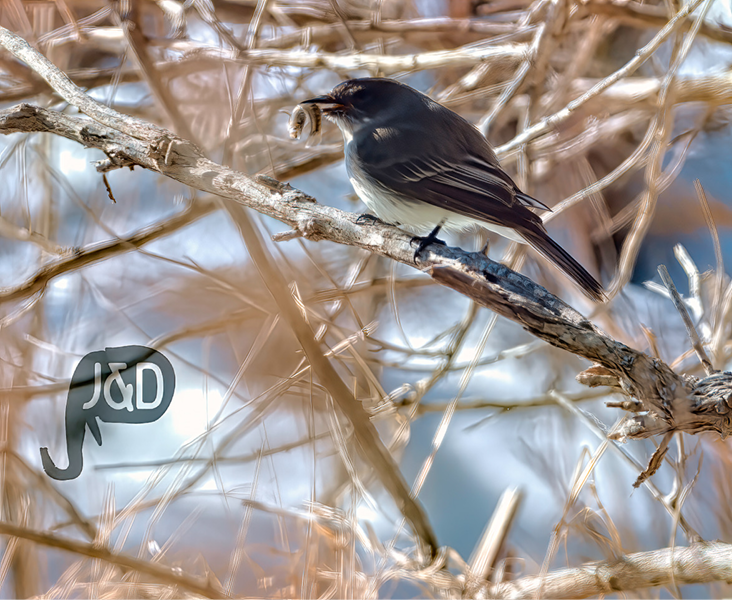Dennis Durette

Eastern Phoebe. Photograph by Dennis Durette.
Allens Pond in South Dartmouth, Massachusetts, is an estuarine, coastal salt pond affected by tidal cycles. Over the past 12 years, I have observed a variety of species such as Ruby-crowned Kinglet, Hermit Thrush, Rusty Blackbird, and Yellow-rumped Warbler in small groups winter here, along with the resident Black-capped Chickadee, Tufted Titmouse, Golden-crowned Kinglet, Belted Kingfisher, and Great Blue Heron.
During the winter of 2021, a lone Eastern Phoebe wintered at the northwest part of the estuary where fresh water enters the marsh from Zylfee Brook, a perennial stream. I have observed Eastern Phoebes during some years, but I have never before seen one dipping for minnows.
I first saw the Eastern Phoebe on the morning of January 9 and again on January 10. January 10 was an unseasonably warm day, with temperatures rising into the high 40s, and both the Eastern Phoebe and five Yellow-rumped Warblers were feeding on insects. At this time, the marsh was starting to flood; the pond’s opening to the sea was closing as it periodically does, and without tidal drainage, the pond was filling like a bathtub with fresh water delivered by several streams in the watershed.
The following weekend, the temperatures soared into the 50s and the Eastern Phoebe was still present, along with numerous other species. The marsh water level had risen high enough to force me to retreat from my usual observation area. My main focus during the long winter hours I’ve spent at this location are the minks that hunt for minnows; Zylfee Brook has its share of predators. In the following weeks, the water level approached the scrub brush of the marsh. My minks were more difficult to observe as they hunted in areas deeper in the brush where the minnows got stranded in small pools. While trying to get a glimpse of the minks, I noticed the Eastern Phoebe struggling to devour something that I could not yet identify. The bird was smashing it on branches, as phoebes do with dragonflies to discard the wings, but to my knowledge there are no dragonflies in January.
I was flooded out of that section of the marsh until February 20 and 21. The outlet of the pond had been reopened to the ocean and the tidal fluctuation returned to normal. The area where the brook drains into the pond is lined with stones, and when the tide recedes, predators take advantage of the minnows trapped in the pools between the rocks. There is an old cedar post that stands in the marsh, a place where the kingfishers often perch between diving for fish. I witnessed the Eastern Phoebe on the kingfishers’ perch. I then watched it hover over the stream as if it were going to pick up an emerging insect from the water, only to see it grab a small minnow, bring it to the brush, and struggle to turn it headfirst and swallow it. It was the only successful capture I saw that morning, although the bird did hover again several more times with no positive results.
The following weekend I returned but no Eastern Phoebe was in sight. I wondered to myself: Was this learned behavior from the kingfishers? I have no doubt that birds react to other birds feeding.